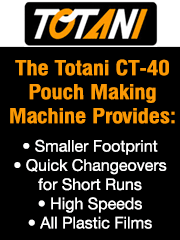Assessing the Potential for Ink Transfer and Migration
- Published: July 01, 2001, By Richard M. Podhajny, Ph.D., Contributing Editor
Recently, I received an e-mail in which a reader questioned whether there's a possibility of ink transfer to the inside wall of a cup printed with UV inks if it is nested inside another printed cup. The simple answer to this question: Yes!
Most printing applications involve some contact with the backside of the printed substrate. In many cases it's possible to see this transfer by applying an alcohol-saturated cotton ball to the area of possible ink transfer, then noting the transferred ink in the discoloration of the cotton ball.
The question of ink transfer goes beyond the specific situation of UV-printed cups; there is the broader possibility of ink transfer within a printed sheet, printed roll, etc. Ink transfer to the backside of substrates is not a new phenomenon. Printers are quite aware of this fact and take precautions to limit the potential transfer.
Many years ago, when the use of lead-based pigments was commonplace, plastic wraps printed with solvent-based flexographic inks could leave a visible amount of ink (via the alcohol-saturated cotton ball wipe) on the inside portion of the roll.
The amount of lead transferred in this way was in the range of several hundred parts per million or more. The amount of ink transferred depended on many variables, including the printed roll internal pressure, wind-up tension, solvent retained levels, and the type of ink used.
Ink transfer within a roll can occur by excessive pressure and, in some cases, by migration of components through the ink film layer. Printed films with high residual solvent particularly are vulnerable to migration of ink components. The movement of plasticizers that affect COF is an example of this type of transfer. The amount of transfer can be quite small, but it is detectable.
In the case of the UV-printed cups, the ink is in contact with both the cup's outer surface and the inner surface of the adjacent cup, and it can transfer under some conditions. Potential transfer in this case depends on many factors, such as degree of cure, ink adhesion, pressure between cups, length of time in contact, etc.
Unlike other ink systems, UV inks “cure” by drying from top down. As a result, depending on the color, the inks can have residual materials left in the ink film. These materials can be transferred directly by physical contact or by migration if they are in contact with the interior of the cup for extended periods.
In a recent article, ink supplier Sicpa noted that when printed packaging materials are stored in a rolled-up form or stacked on or inside each other, the printed outside surface will be in close contact with the inside of the packaging for a prolonged time.
Because of this situation, Sicpa adds, migrating materials from the ink can be deposited on the inside and can, in fact, come into direct contact with the food.
In cases where FDA compliance is required for direct food contact, the only sure way a noncompliant ink will not be deposited on the inside of the cup and eventually be ingested by the customer, is to use an FDA-compliant, direct-food-contact ink.
It is important to note that inks or coatings that are not approved for direct food contact are used in applications where a “functional barrier” is present. However, if these inks are transferred within the roll or into the cup, they would require compliance as “food additives.”
Good manufacturing practices established over many years within the converting and printing industry reduce the chances of ink transfer. These practices include tests for retained solvents (to assess degree of drying and potential for odor); ink adhesion (if inks can rub off or flake off the surface); surface tension (to predict level of ink adhesion); and ink blocking (softness of the ink).
Dr. Richard M. Podhajny has been in the packaging and printing industry for more than 30 years. Contact him at 215/616-6314, e-mail: rpodhajny@colorcon.com.













